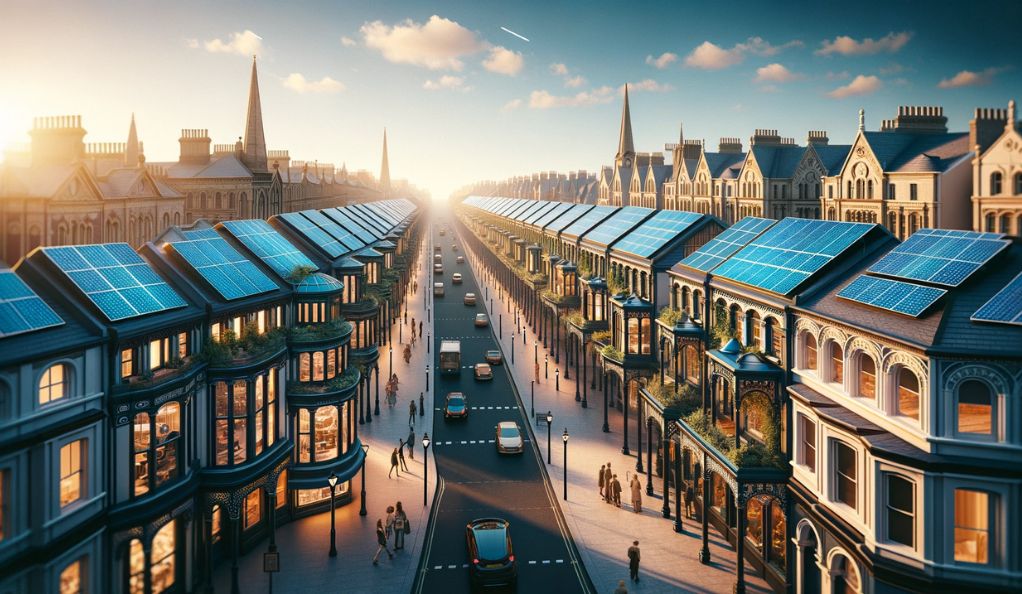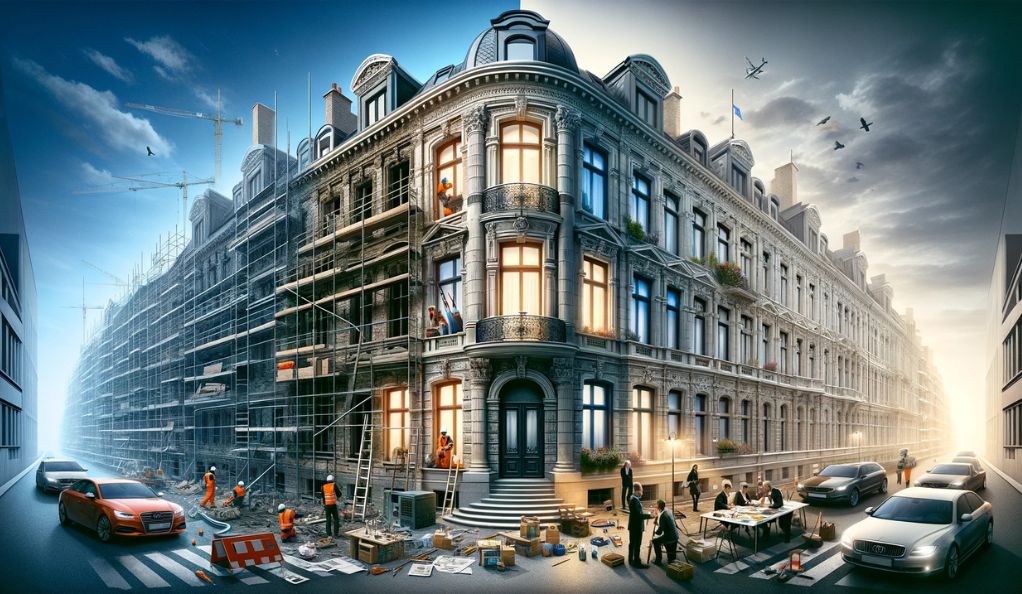The integration of solar energy technology into historic buildings represents a significant step forward in the quest to blend past and future for sustainable living. This initiative is not just about adopting renewable energy sources; it’s about respecting and preserving our architectural heritage while embracing the benefits of modern technology.
The Importance of Preserving Historic Buildings
Historic buildings are not only aesthetic landmarks but are also embodiments of our cultural and architectural heritage. They offer a tangible connection to our past, showcasing the architectural styles, materials, and craftsmanship of bygone eras. However, historic buildings often face the challenge of maintaining relevance in the modern world, especially in terms of energy efficiency.
Rising Trend of Integrating Solar Panels in Historic Structures
The integration of solar panels on historic buildings is a burgeoning trend, balancing the need for energy efficiency with preserving these cherished structures. Innovative solutions like thin-film solar panels, Building-Integrated Photovoltaics (BIPV), and custom-designed solar solutions enable discreet installations that maintain architectural and historical integrity. Solar energy offers sustainable and cost-effective solutions, reducing reliance on non-renewable sources, lowering energy costs, and curbing carbon emissions from historic buildings.
The Aesthetics of Solar Panels in Historical Context

Integrating solar panels into historic buildings is an art that balances modern energy needs with preserving architectural heritage. This section explores how solar technology can be harmoniously blended with historical aesthetics, ensuring that these buildings maintain their original character while becoming more energy efficient.
Design Considerations for Maintaining Architectural Integrity
This requires a thoughtful approach to the design and placement of solar panels. Design considerations include:
- Color, Texture, and Material Matching: Solar panels should complement the building’s existing roofing or façade. This involves selecting panels with colors and textures that closely match the original materials.
- Low-Profile Mounting Systems: The mounting systems for solar panels should be as unobtrusive as possible. Low-profile mounts that blend seamlessly with the historic architecture are preferred to minimize visual impact.
- Strategic Placement: Solar panels should be placed in less visible areas, such as rooftops that are not easily seen from the ground level. This approach helps maintain the visual integrity of the building while harnessing solar energy.
Examples of Aesthetically Pleasing Solar Installations in Historic Settings
Here are a few examples:
- Transparent Solar Windows: Some historic buildings use transparent solar windows, preserving aesthetics while generating energy.
- Solar Panels as Tiles: Solar panels can mimic roofing tiles, seamlessly blending with the original design.
- Custom Solar Solutions: Unique buildings benefit from tailored solar panels, matching architectural elements or themes perfectly.
Energy Efficiency and Environmental Impact
Incorporating solar panels into historic buildings represents more than just an architectural endeavor; it’s a stride towards enhanced energy efficiency and environmental sustainability. This segment explores how solar energy benefits historic buildings by diminishing their carbon footprint, aligning them with contemporary environmental objectives.
Benefits of Solar Energy for Historic Buildings
- Reduced Carbon Footprint: Solar panels harness renewable solar energy, reducing reliance on fossil fuels and cutting greenhouse gas emissions, promoting a greener environment.
- Energy Cost Savings: Solar panels mitigate high energy expenses in historic buildings, generating free electricity for substantial long-term savings.
- Sustainability: Solar energy aligns with global climate change mitigation, making historic buildings exemplify sustainable preservation.
Environmental Impact of Solar Panels on Historic Buildings
- Reduced Dependency on Non-Renewable Energy: Integrating solar panels decreases a building’s dependence on non-renewable energy sources, thereby contributing to a reduction in overall environmental pollution.
- Sustainable Preservation: Solar panels ensure that historic buildings remain functional and relevant in today’s world, contributing to their ongoing preservation in an environmentally friendly manner.
- Long-Term Environmental Benefits: The long lifespan of solar panels means that historic buildings can continue to reap environmental benefits for decades, making a sustained contribution to eco-friendly practices.
Technological Innovations in Solar Panel Design
The push towards integrating solar panels into historic buildings has driven significant advancements in solar technology, focusing on aesthetic adaptability and minimal architectural disruption. This section discusses the cutting-edge innovations that are making solar panels more compatible with the unique demands of historic buildings.
Transparent Solar Windows
One of the most revolutionary advancements in solar panel technology for historic buildings is the development of transparent solar windows. These innovative panels serve a dual purpose: generating electricity while functioning as regular windows.
- Functionality: Transparent solar windows are designed to harvest solar energy without obstructing natural light. They can replace existing windows, ensuring minimal impact on the building’s visual aesthetics.
- Visual Impact: These solar windows maintain the transparency and appearance of traditional glass, making them an ideal choice for historic buildings where preserving the original look is crucial.
Solar Panels Disguised as Building Materials
Another innovative approach is the creation of solar panels designed to mimic traditional building materials, such as tiles or shingles.
- Aesthetic Integration: These solar tiles or shingles are crafted to blend seamlessly with the historic building’s roof, preserving the architectural style and historical value.
- Efficiency: Despite their discreet appearance, these solar materials are efficient in harnessing solar energy, offering a practical solution for energy generation without compromising the building’s integrity.
Custom-Designed Solar Solutions
Custom-designed solar solutions are crucial for buildings with unique architectural features or strict historic preservation requirements.
- Tailored Designs: These solar panels are specially designed to match the unique architectural elements of each historic structure, allowing for a harmonious integration.
- Architectural Synergy: By working closely with architects and preservationists, solar panel manufacturers can create solutions that respect the historical significance and visual appeal of the building.
Challenges and Solutions in Retrofitting Historic Buildings

Retrofitting historic buildings with solar panels presents unique challenges, from preserving architectural integrity to navigating regulatory landscapes. This section outlines these challenges and the innovative solutions being implemented to address them.
Navigating Preservation Guidelines and Structural Constraints
Historic buildings, cherished for their architectural and historical significance, face unique challenges when considering solar panel installations. Compliance with strict preservation standards and structural limitations pose hurdles. Solutions involve collaborating with preservation authorities, architects, and solar experts to design panels that align with energy and preservation goals.
Financial Benefits and Incentives
This section highlights the economic advantages and available incentives that make solar retrofitting an attractive option for owners of historic properties.
Economic Advantages of Solar Panels in Historic Buildings
- Lowered Energy Costs: Solar panels reduce expenses by generating renewable electricity, crucial for energy-intensive historic buildings.
- Higher Property Value: Solar installations boost historic building value, attracting sustainability-conscious buyers and tenants.
- Long-Term Savings: Solar panels require minimal upkeep and offer free electricity after the initial investment, ensuring lasting savings for historic properties.
Incentives for Solar Panel Installation
Several federal, state, and local incentives are available to encourage the installation of solar panels in historic buildings:
- Federal Tax Credits: The Investment Tax Credit (ITC) allows property owners to deduct a significant percentage of their solar installation costs from their federal taxes.
- State and Local Incentives: Many states and municipalities offer additional incentives, such as rebates, property tax exemptions, and grant programs specifically for renewable energy projects.
- PACE Financing: Property Assessed Clean Energy (PACE) programs enable property owners to finance solar installations through an assessment on their property tax bill, often with favorable terms.
Community Engagement and Educational Opportunities
The integration of solar panels into historic buildings not only contributes to sustainability and preservation but also opens avenues for community engagement and educational opportunities. This section explores how solar-powered historic buildings can become platforms for public involvement and awareness around renewable energy and heritage conservation.
Fostering Community Involvement
- Educational Tours: Solar-powered historic sites offer educational opportunities, raising awareness about renewable energy and preservation through tours and events.
- School Collaborations: Partner with schools and universities for research and educational programs, fostering sustainable preservation understanding.
- Publicity & Tourism: Solar historic buildings draw media attention, boosting tourism and community pride as symbols of innovative preservation and sustainability.
Enhancing Cultural Heritage Appreciation
Weaving history and sustainability through storytelling involves integrating modern technology, such as solar panels, into historic structures. This narrative educates and inspires communities about their local heritage and environmental responsibility. Additionally, hosting events that focus on heritage conservation and sustainability fosters community discussions and collaborations, emphasizing the importance of preserving historic buildings in the contemporary context.
Conclusion
Integrating solar panels into historic buildings harmoniously combines preservation and sustainability. This approach safeguards architectural heritage and propels structures into an era of environmental responsibility. Innovative solar technologies and sensitive implementation preserve the buildings’ aesthetic and historical integrity while reaping renewable energy benefits.
